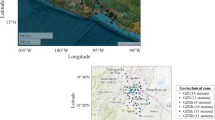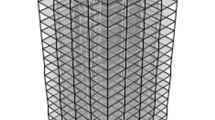Abstract
The impact of the June 2000 South Iceland earthquakes has been assessed applying data collected in field surveys and strong-motion recordings from the Icelandic Strong-Motion Network. The areas within approximately 20 km of the causative faults suffered considerable damage, including transportation and utility systems as well as buildings, both with regard to structure and inventories. Ground subsidence and dislocations were significant in the near-fault zone. Aftershocks and permanent displacements of building foundations resulted in progressive structural damage. By introducing holistic measures derived from the acceleration data, a fair correlation was achieved between the obtained earthquake intensities and the recorded accelerations. The measures adopted were square root of the sum of the squares (SRSS) values of peak ground acceleration (PGA) and the trace of the Arias intensity tensor. It was found that the overall attenuation tended to be more rapid than reflected by common strong-motion models reported in the literature. There is no simple explanation for this behaviour but it is reasonable to suggest that it can be partly attributed to the heterogeneous and fractured crust that is characteristic of Icelandic geology.
Similar content being viewed by others
References
Ákason JB, Ólafsson S and Sigbjörnsson R (2006a). Phases of earthquake experience: a case study of the June 2000 South Iceland earthquakes. Risk Anal 26(5): 1235–1246
Ákason JB, Ólafsson S and Sigbjörnsson R (2006). Perception and observation of residential safety during earthquake exposure: a case study. Saf Sci 44: 919–933
Ambraseys NN, Smit PM, Douglas J, Margaris B, Sigbjörnsson R, Ólafsson S, Suhadolc P and Costa G (2004). Internet site for European strong-motion data. Bollettino di Geofisica Teorica ed Applicata 45(3): 113–129
Ambraseys NN, Sigbjörnsson R (2000) Re-appraisal of the seismicity of Iceland. Earthquake Engineering Research Centre, University of Iceland, Selfoss
Ambraseys NN, Douglas J, Sarma SK and Smit P (2005). Equations for the estimation of strong ground motions from shallow crustal earthquakes using data from Europe and the Middle East: horizontal peak ground acceleration and spectral acceleration. Bulletin of Earthquake Engineering 3(1): 1–53
Albarello D and D’Amico V (2004). Attenuation relationship of macroseismic intensity in Italy for probabilistic seismic hazard assessment. Bollettino di Geofisica Teorica ed Applicata 454(4): 271–284
Arias A (1970). A measure of earthquake intensity. In: Hansen, RJ (eds) Seismic design for nuclear power plants., pp. MIT Press, Cambridge
Bessason B and Haflidason E (2004). Recorded and numerical strong motion response of a base-isolated bridge. Earthquake Spectra 20(2): 309–332
Boore DM (1983). Stochastic simulation of high-frequency ground motions based on seismological models of the radiated spectra. Bull Seismolo Soci Am 73: 1865–1894
Boore DM, Atkinson GM (2007) Ground-motion prediction equation for the average horizontal component of PGA, PGV and 5%-damped SA at spectral periods between 0.01 s and 10.0 s. Report on NGA-project, April 2007
Campbell KW, Bozorgnia Y (2006) Campbell-Bozorgnia NGA empirical ground motion model for the average horizontal component of PGA, PGV, PGD and SA at selected spectral periods ranging form 0.01–10.0 seconds. Version 1.1, December 2006
Clough R and Penzien J (1975). Dynamics of structures. McGraw-Hill, New York
Comez CAA (2006). Seismic hazard map for the Italian territory using macroseismic data. Earth Sci Res J 10(2): 67–90
Douglas J (2004). An investigation of analysis of variance as a tool for exploring regional differences in strong ground motions. J Seismol 8(4): 485–496
Dowrick DJ (1992). Attenuation of modified Mercalli Intensità in New Zealand. Earthquake Engineering and Structural Dynamics 21: 181–196
Global CMT Catalog (2007) http://www.globalcmt.org/CMTsearch.html. Cited 22 June 2007
Gudmundsson A (2000). Dynamics of volcanic systems in Iceland: example of teconism and volcanism at juxtaposed hot spot and mid-ocean ridge systems. Annu Rev Earth Planet Sci 28: 107–140
Grünthal G (1998). European macroseismic scale. European Seismological Commission, Luxemborg
Harboe EG (1913). Das islaendische Erdbeben am 22 Januar 1910. Gerl Beitr Geophys 12: 27–40
Harboe EG (1914). Das islaendische Hekla-Beben am 6 Mai 1912. Gerl Beitr Geophys 13: 173–183
Musson RMW (2000). Intensity-based seismic risk assessment. Soil Dyn Earthq Eng 20(5–8): 353–360
Musson RMW (2005). Intensity attenuation in the UK. J Seismol 9: 73–86
Ólafsson S, Sigbjörnsson R and Einarsson P (1998). Estimation of source parameters and Q from acceleration recorded in the Vatnafjoll earthquake in South Iceland. Bull Seismol Soc Am 88(2): 556–563
Ólafsson S (1999). Estimation of earthquake-induced response. Norwegian University of Science and Technology, Trondheim
Ólafsson S, Sigbjörnsson R (2006) Attenuation in Iceland compared with other regions. Proceedings of the 1st European conference on earthquake engineering and seismology, Geneva: SGEB, 3–8 September 2006
PEER-NGA strong motion database (2007) http://www.peer.berkeley.edu/nga. Cited 19 June 2007
Sieberg A (1920) Mitteilung über Erdbeben im Jahre 1912. Herausgegeben von der Haubtstation für Erdbebenforschung, früher Strassburg, Jena
Sigbjörnsson R (2002) Strong-motion study of the South Iceland Earthquakes 2000. Proceedings of the 12th european conference on earthquake engineering, London, UK, 9–13 September 2002
Sigbjörnsson R, Ólafsson S, Thorarinsson O (2004) Strong-motion recordings in Iceland. Proceedings of the 13th world conference on earthquake engineering, Vancouver, Canada, 1–6 August 2004
Sigbjörnsson R and Ólafsson S (2004). On the South Iceland earthquakes in June 2000: strong-motion effects and damage. Bollettino di Geofisica Teorica ed Applicata 45: 131–152
Thoroddsen T (1901). Das Erdbeben in Island im Jahre 1896. Petterm Mitteil 47: 53–56
Thorarinsson S (1937). Das Dalvik-Beben in Nord-Island 2 Juni 1934. Geograph Annaler 3–4: 232–277
Tryggvason E (1979) Earthquakes in Iceland 1950–1959. The Science Institute, University of Iceland, Report RH-79–06, Reykjavík
Wood HO and Neuman F (1931). Modified mercalli intensity scale. Bull Seismol Soc Am 21(4): 277–283
Author information
Authors and Affiliations
Corresponding author
Rights and permissions
About this article
Cite this article
Sigbjörnsson, R., Ólafsson, S. & Snæbjörnsson, J.T. Macroseismic effects related to strong ground motion: a study of the South Iceland earthquakes in June 2000. Bull Earthquake Eng 5, 591–608 (2007). https://doi.org/10.1007/s10518-007-9045-2
Received:
Accepted:
Published:
Issue Date:
DOI: https://doi.org/10.1007/s10518-007-9045-2




